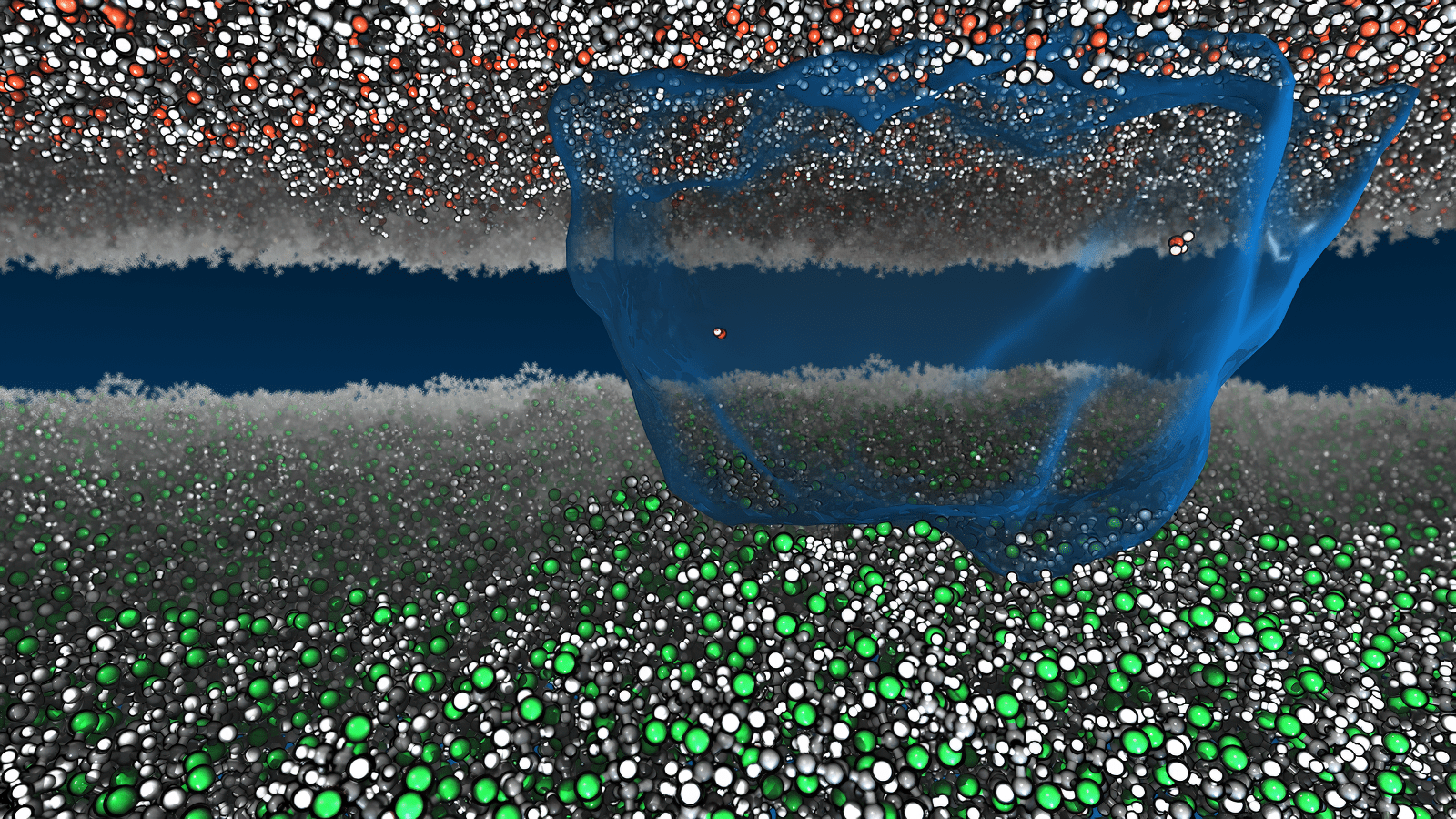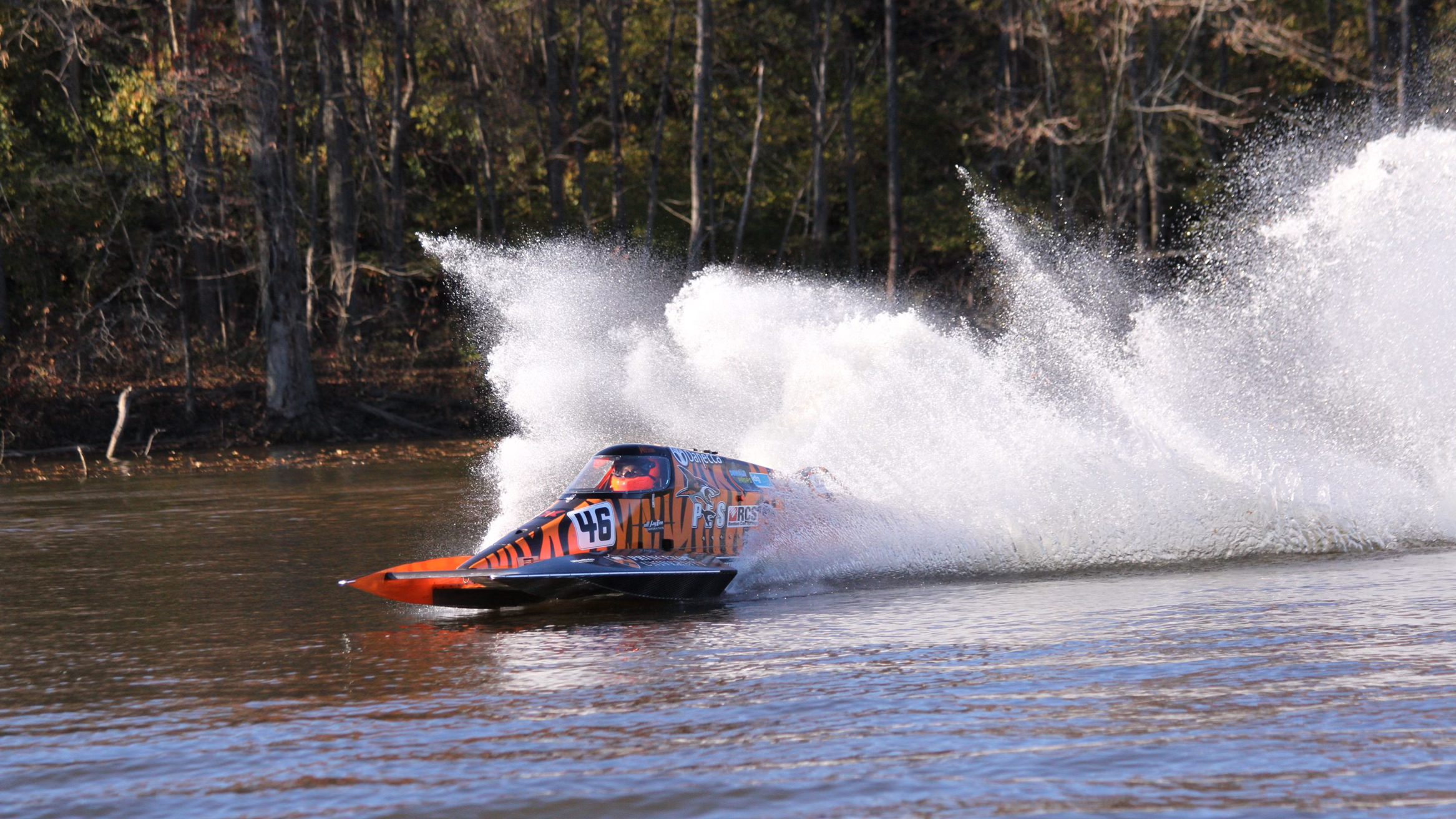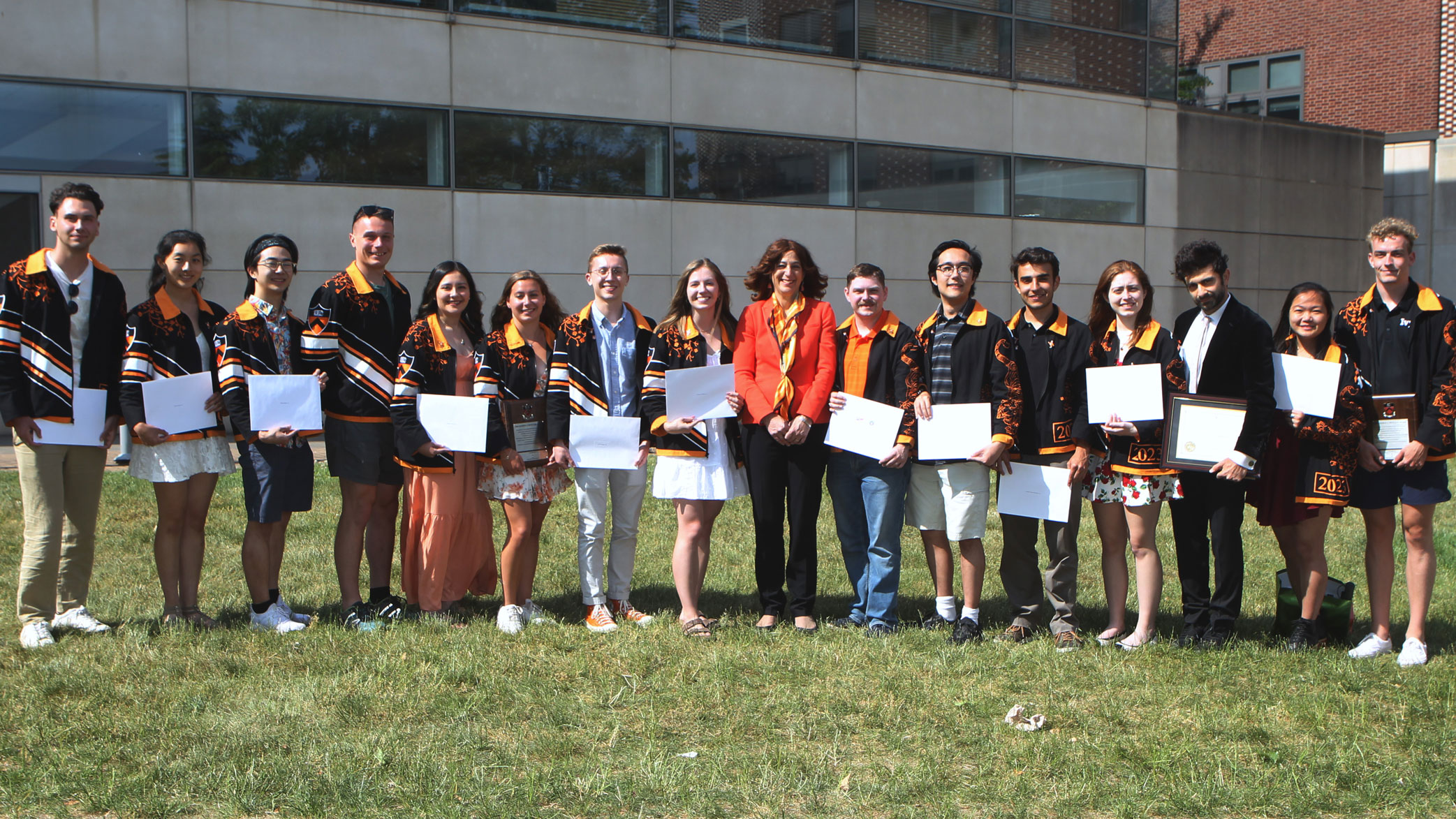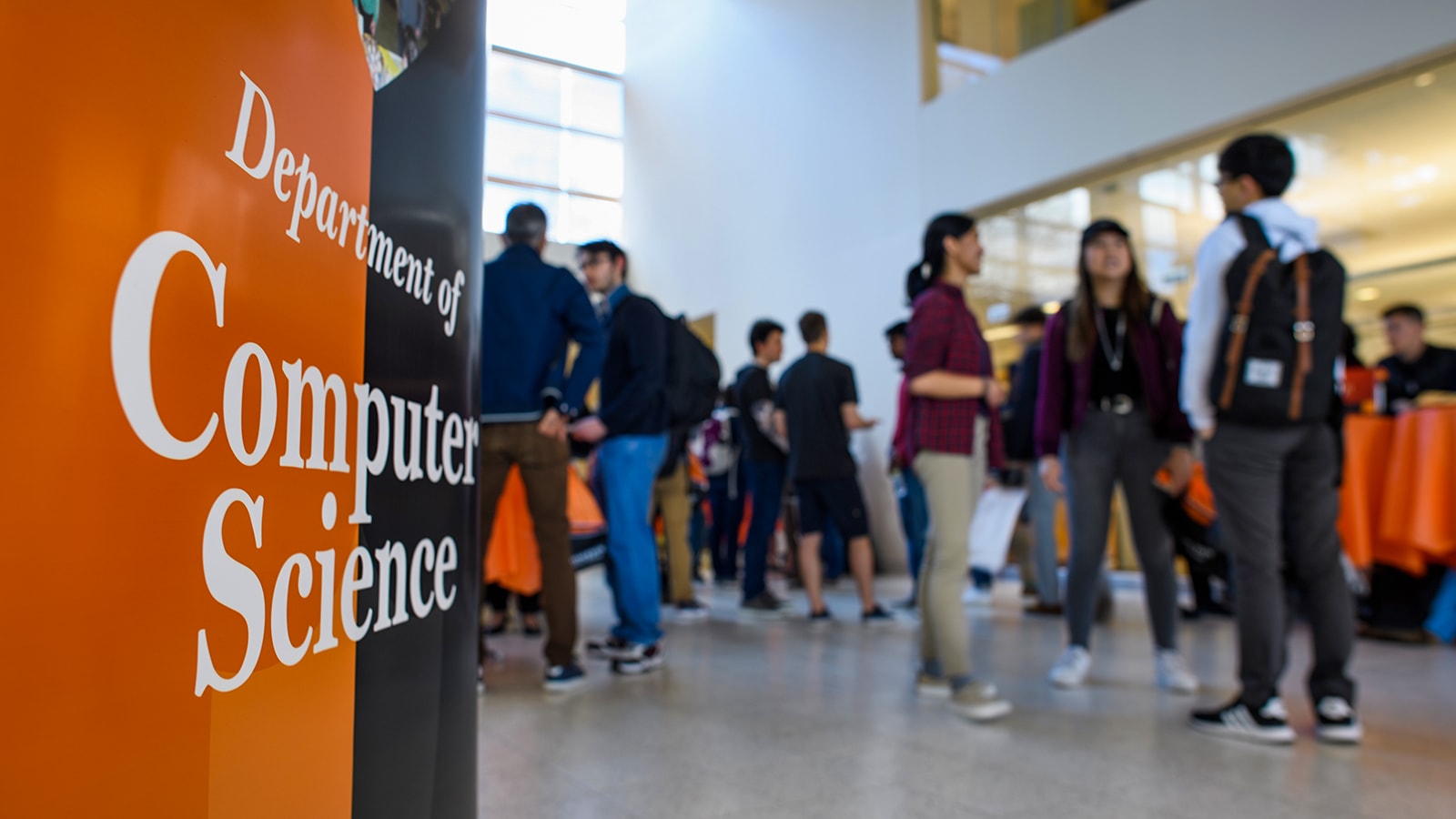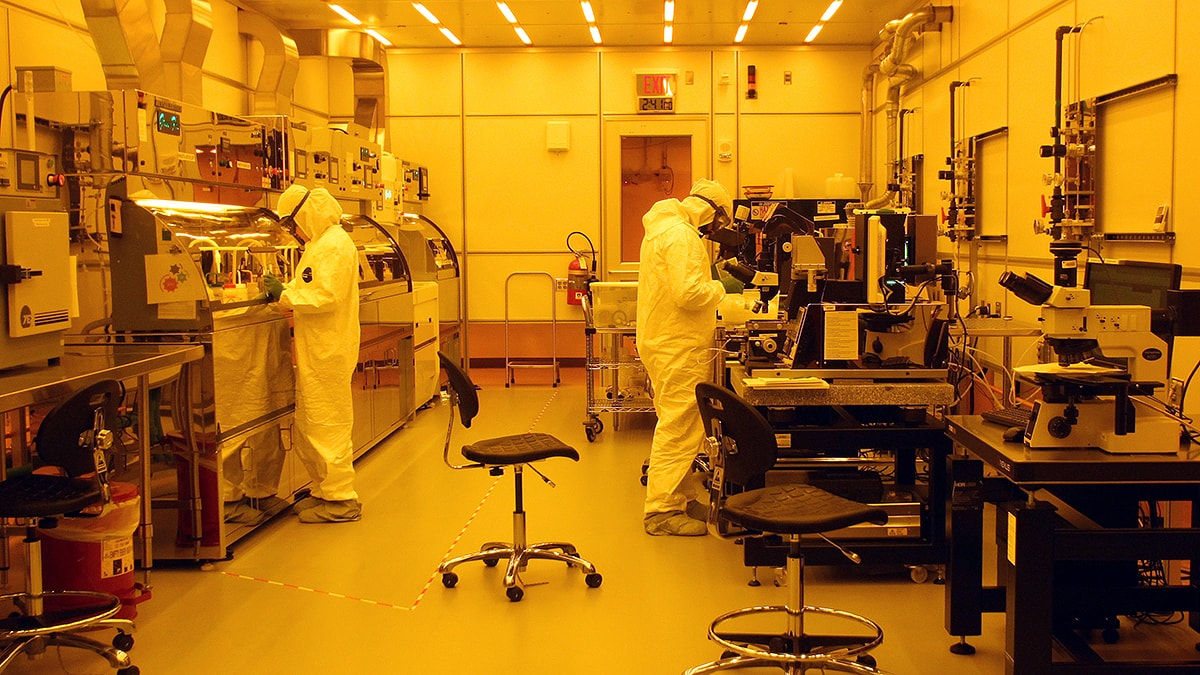Their engineering skills have already shed new light on important questions in neuroscience, advanced the quest for solar energy and aided communities in the developing world. Princeton University honored these and many other accomplishments of its 176 graduating engineers at Class Day and Commencement ceremonies June 2 and 3.
“This is a class with very broad accomplishments and interests,” said Dean H. Vincent Poor as he addressed engineering students in the Class of 2008 and their parents at the School of Engineering and Applied Science Class Day ceremony on the Friend Center green.
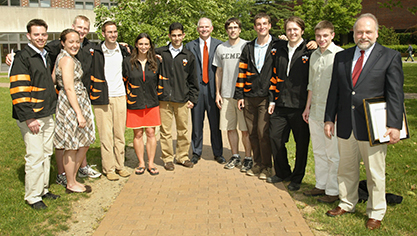
The newly minted alumni are heading to graduate school at Oxford University, the Massachusetts Institute of Technology, Stanford University, Princeton and many other schools. Some are taking jobs with industry leaders, such as Merck, Google and Boeing. Beyond engineering, graduates are going into finance, law, military service and even professional sports. Others will be teaching in elementary and high schools and participating the Princeton in Asia, Princeton in Latin America and Princeton in Africa programs.
“This proves that an engineering education is a good foundation for just about anything you want to do,” Poor said.
One of the University’s top honors went to James Morrison, a chemical engineering major from Kensington, Maryland, who delivered the traditional Latin address at Commencement as the salutatorian of the class of 2008. Morrison earned the top ranking in his department while developing an additional expertise in classics and the Latin language. (See story.)
At the University-wide Class Day ceremony on June 2, Thomas Lipp of New Haven, Conn., won the Harold Willis Dodds Prize, which recognizes seniors who best embody the qualities of Princeton’s 15th president, Harold Dodds, “particularly in the qualities of clear thinking, moral courage, a patient and judicious regard for the opinions of others, and a thorough devotion to the welfare of the University and to the life of the mind.” Lipp, a mechanical and aerospace engineering major, was a peer educator on lesbian, gay, bisexual and transgender issues and served as president and vice president of the Pride Alliance. He was a member of the engineering honors association Tau Beta Pi and the University Film Organization and served as a Mathey College undergraduate fellow.
The engineering school also honored 16 students for their outstanding achievements in academics, research and service:
Landis Stankievech, a mechanical and aerospace engineering major from Trochu, Alberta, Canada, shared the James Hayes-Edgar Palmer Prize in Engineering, which is awarded to seniors who have “manifested excellence in scholarship, a marked capacity for leadership and promise of creative achievement in engineering.” He also won the George J. Mueller Award, which is awarded to the graduating student who has “most evidently combined high scholarly achievement in the study of engineering with quality performance in intercollegiate athletics.”
In his academic work, Stankievech conducted theoretical research involving the modeling and simulation of dynamic systems with random inputs. His advisor, Professor Jeremy Kasdin, said, “the work was beautiful and the report extremely well written and clear. The results are fantastic.” Professor Michael Littman said that Stankievech impressed the engineering faculty with a “thirst for knowledge, a real knack for engineering analysis, being a natural and effective leader, and being a humble helper of his peers.” He took courses in 12 departments and earned 16 grades of A+.
Stankievech, who previously won a Rhodes Scholarship and will be studying at Oxford next year, was an award-winning player on Princeton’s men’s ice hockey team. He also received the University’s Class of 1916 Cup for the varsity letter winner with the highest academic standing and previously won the Moses Taylor Pyne Honor Prize, the highest general distinction conferred on an undergraduate.
Amirali Modir Shanechi, an electrical engineering major from Toronto, Canada, shared (with Stankievech) the James Hayes-Edgar Palmer Prize, and also won the Jeffrey O. Kephart ’80 Prize in Engineering Physics. Shanechi developed a novel optical sensor for detecting trace amounts of gases in liquids, such as carbon dioxide in the blood. His advisor, Professor Claire Gmachl, said that his work is “at the forefront of non-invasive optical sensing.” Gmachl added that Shanechi is a “rare student, one of those who come around only every few years.” Taking courses in 12 departments, he earned grades of A+ in 20 courses. With certificates in engineering physics and applications of computer, he will attend medical school at Washington University.
Brendan Collins and Baris Ungun won the Calvin Dodd MacCracken Senior Thesis/Project Award, which recognizes the senior thesis or project that is “most distinctive for its inventiveness and technical accomplishment.”
Collins, a computer science major from West Bloomfield, Michigan, conducted research that advanced the field of image search and classification. He invented a computing method that allows users to annotate a small number of images and then learns from those annotations to tag, link and classify the rest of a database of 10 million images. He is the first author on a paper submitted to the prestigious European Conference on Computer Vision. He also has been heavily involved in the Princeton Autonomous Vehicle Project, which received national attention in competitions, and was part of a group that took first place in a visual robot competition. He will join Two Sigma Investments in New York City.
Ungan, a chemical engineering major from San Carlos, California, conducted research that combined an understanding of optics, fluid mechanics, chemistry and the self-assembly of polymers. He created composite nanoparticles for potential use in photodynamic medical therapies. He will go to work for Gilead Sciences in their process development and formulations research group.
Szymon Plucinski and Kira Schiavello won the J. Rich Steers Award, which is given to the New York Post of the Society of American Military Engineers, “to reward scholastic performance that demonstrates potential for further engineering practice and study.”
Plucinski, a mechanical and aerospace engineering major from Glen Dale, West Virginia, studied a potential method for using a process like photosynthesis as a source of energy, converting sunlight to chemical energy that is stored as carbohydrates. Plucinski will attend graduate school at Stanford.
Schiavello, a civil and environmental engineering major from Saddle River, New Jersey, conducted a study of bridge design that her advisors, professors Maria Garlock and Theodore Zoli, said provides remarkable insights to bridge designers. She has won a Guggenheim Fellowship to pursue a graduate degree at Columbia University.
Peter Curtin, a chemistry major from Wilmington, North Carolina, won the Global Photonic Corporation Edith and Martin B. Stein Solar Energy Award, given to a student “who has demonstrated excellence in leadership and innovation in research that significantly advances the field of global renewable energy resources.” Curtin, who is also receiving a certificate in applications of computing, developed a novel experimental system that led to potentially improved catalysts for us in solar energy production. He will attend graduate school at MIT.
Thomas Lipp, who also won the University’s Dodd Prize (mentioned above), won the PRISM-Newport Award in Photonics. Conducting his thesis in the lab of Professor Craig Arnold, he worked on the development of a quickly tunable lens that is more than 1,000 times faster than competing approaches. “Through Thomas’ efforts in both design and research, we have been able to move the technology from a clunky laboratory fixture to a sleek device that can be directly integrated with traditional optical components,” said Arnold. “We will most definitely be referring to Thomas’ thesis for some time to come as we continue research in this important area.” Lipp is the first author of a paper on the subject to appear later this summer.
Megan McNall and James Morrison won the Tau Beta Pi Prize, which is awarded to members of the senior class who have significantly contributed a major part of their time to service of the engineering school.
Morrison, who also was the University’s Latin salutatorian (see above), organized and led the tour program for the engineering school, which is given 10 times a week when classes are in session. Associate dean Peter Bogucki praised Morrison for having “reestablished our tour program on a sound footing of shared responsibility.” In his academic work, Morrison’s research in nanotechnology that could be used in new generations of electronic devices led to publication-quality results, according to one of his advisors, Professor Pablo Debenedetti. Morrison also earned a certificate in engineering physics. In the fall, he will start working in quantitative finance at Goldman Sachs.
McNall, a civil and environmental engineering major from Fort Wayne, Indiana, served as president of the student Engineering Council for two years and held responsibility for the council’s teaching awards program before that. An outstanding student, she also received certificates in materials science and engineering and in Italian Languages and Culture. For her thesis, she conducted research that her advisor, Professor George Scherer, said has resolved longstanding questions about how polyacrylic acid protects limestone from degradation. She will continue as a graduate student at Princeton next year.
Michael Moore and Ishani Sud, won the Joseph Clifton Elgin Prize, which is awarded to seniors who “in the judgment of the dean and the departmental chairs has done the most to advance the interests of the school in the community at large.
Moore, a mechanical and aerospace engineering major from Calgary, Canada, was recognized for his contributions to the Princeton community, his outstanding athletic performance and strong academic achievements. In his freshman year, Moore joined the Princeton volunteer fire department, spent many hours in training and served with Engine Company 61 throughout his four years. He also inspired a number of his fellow students to join and was praised by the fire chief as someone who “always gives 100 percent” in this demanding commitment to serving the community. He was a four-year standout on the men’s hockey team and also was active in the Princeton Youth Hockey Association, mentoring young players. He has signed with the San Jose Sharks in the National Hockey League to play professional hockey next year.
Sud, a chemical engineering major from Durham, North Carolina, earned four certificates in addition to her major: engineering biology; materials science and engineering; neuroscience; and the Woodrow Wilson School of Public and International Affairs. She worked with the Global Development Network, a program sponsored by the National Science Foundation and directed by Professor Wole Soboyejo. She played a major role in developing and deploying technologies for solar cooking and water purification in Kenya, Tanzania and elsewhere, in collaboration with other Princeton engineering students. “Ishani exemplifies the whole notion of Princeton engineering in the service of the world,” Soboyejo said. “She has worked within the Global Development Network family to change the lives of school children in Kenya and Tanzania, while pioneering new ways of solving basic problems of energy and water in the developing world.” Named one of Princeton University’s first “Scholars in the Nations Service,” she will work for two years in government service and then return to the Woodrow Wilson School for a maters in public policy degree.
Francois Bellemare, Kohler Johnson and Andrew Saxe shared the Lore von Jaskowsky Memorial Prize for students who have made a contribution to their field of research and contributed to the quality of University life through their interactions with students, faculty and staff.
Bellemare, who is from Quebec, Canada, and Johnson, who is from Gaston, Oregon, both majored in mechanical and aerospace engineering and worked with Professor Edgar Choueiri on designing, building and testing a central component of an instrument that could be sent to Mars to perform mass spectrometry on soil samples. “They quickly became residents of my lab and spent much of their time doing school work and research among the graduate students, who admired them and treated them as their peers,” said Choueiri, who added that their work “is already serving as the centerpiece of my lab’s research” on the mass spectrometry project. Bellemare will work for Oliver Wyman Financial Services, and Johnson is weighing graduate school at the University of Washington or a job in industry.
Saxe, an electrical engineering major from Los Altos, California, also earned certificates in applications of computing, robotics and intelligent systems, and applied and computational math. He conducted research in computational neuroscience, working closely with Professor Ken Norman in the Department of Psychology. His thesis “constitutes real progress toward understanding some of the deepest, most difficult questions in computational neuroscience: what is the algorithm that the brain uses to adjust connections, and how is this algorithm implemented in realistic spiking networks?” wrote Norman. “This research is absolutely cutting edge and‚Ķ it will have huge impact when it is published.” Norman said he turned his weekly meeting with Saxe into an open discussion seminar for his research group, led by Saxe.
Saxe also was a key member of the highly successful Princeton Autonomous Vehicle Engineering team, recognized for its entries in the DARPA Grand Challenge competitions of 2005 and 2007. As an outgrowth of that team, he also participated in the 2008 Intelligent Ground Vehicle Competition, and helped the Princeton team take first place in one of the competition categories. Next year, Saxe will join a Ph.D. program at Stanford.

